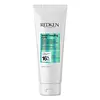What's inside
What's inside
 Key Ingredients
Key Ingredients

No key ingredients
 Benefits
Benefits

 Concerns
Concerns

 Ingredients Side-by-side
Ingredients Side-by-side

Water
Skin ConditioningSorbitol
HumectantCetearyl Alcohol
EmollientGlycerin
HumectantBehentrimonium Chloride
PreservativePersea Gratissima Oil
Skin ConditioningBis-Diglyceryl Polyacyladipate-2
EmollientTocopheryl Acetate
AntioxidantCamelina Sativa Seed Oil
Skin ConditioningPhenoxyethanol
PreservativeHydroxyethyl Urea
HumectantCetyl Esters
EmollientParfum
MaskingIsopropyl Alcohol
SolventPolyquaternium-37
Sodium Citrate
BufferingPolyquaternium-4
Propylene Glycol Dicaprylate/Dicaprate
EmollientCitric Acid
BufferingPectin
Emulsion StabilisingLimonene
PerfumingPPG-1 Trideceth-6
Skin ConditioningGlycine
BufferingSucrose
HumectantLinalool
PerfumingAcrylates/Stearyl Methacrylate Copolymer
Emulsion StabilisingSorbitan Oleate
EmulsifyingCitronellol
PerfumingCitral
PerfumingEugenol
PerfumingEDTA
Tocopherol
AntioxidantHelianthus Annuus Seed Oil
EmollientRosmarinus Officinalis Leaf Extract
AntimicrobialWater, Sorbitol, Cetearyl Alcohol, Glycerin, Behentrimonium Chloride, Persea Gratissima Oil, Bis-Diglyceryl Polyacyladipate-2, Tocopheryl Acetate, Camelina Sativa Seed Oil, Phenoxyethanol, Hydroxyethyl Urea, Cetyl Esters, Parfum, Isopropyl Alcohol, Polyquaternium-37, Sodium Citrate, Polyquaternium-4, Propylene Glycol Dicaprylate/Dicaprate, Citric Acid, Pectin, Limonene, PPG-1 Trideceth-6, Glycine, Sucrose, Linalool, Acrylates/Stearyl Methacrylate Copolymer, Sorbitan Oleate, Citronellol, Citral, Eugenol, EDTA, Tocopherol, Helianthus Annuus Seed Oil, Rosmarinus Officinalis Leaf Extract
 Reviews
Reviews

Ingredients Explained
These ingredients are found in both products.
Ingredients higher up in an ingredient list are typically present in a larger amount.
Parfum is a catch-all term for an ingredient or more that is used to give a scent to products.
Also called "fragrance", this ingredient can be a blend of hundreds of chemicals or plant oils. This means every product with "fragrance" or "parfum" in the ingredients list is a different mixture.
For instance, Habanolide is a proprietary trade name for a specific aroma chemical. When used as a fragrance ingredient in cosmetics, most aroma chemicals fall under the broad labeling category of “FRAGRANCE” or “PARFUM” according to EU and US regulations.
The term 'parfum' or 'fragrance' is not regulated in many countries. In many cases, it is up to the brand to define this term.
For instance, many brands choose to label themselves as "fragrance-free" because they are not using synthetic fragrances. However, their products may still contain ingredients such as essential oils that are considered a fragrance by INCI standards.
One example is Calendula flower extract. Calendula is an essential oil that still imparts a scent or 'fragrance'.
Depending on the blend, the ingredients in the mixture can cause allergies and sensitivities on the skin. Some ingredients that are known EU allergens include linalool and citronellol.
Parfum can also be used to mask or cover an unpleasant scent.
The bottom line is: not all fragrances/parfum/ingredients are created equally. If you are worried about fragrances, we recommend taking a closer look at an ingredient. And of course, we always recommend speaking with a professional.
Learn more about ParfumWater. It's the most common cosmetic ingredient of all. You'll usually see it at the top of ingredient lists, meaning that it makes up the largest part of the product.
So why is it so popular? Water most often acts as a solvent - this means that it helps dissolve other ingredients into the formulation.
You'll also recognize water as that liquid we all need to stay alive. If you see this, drink a glass of water. Stay hydrated!
Learn more about Water